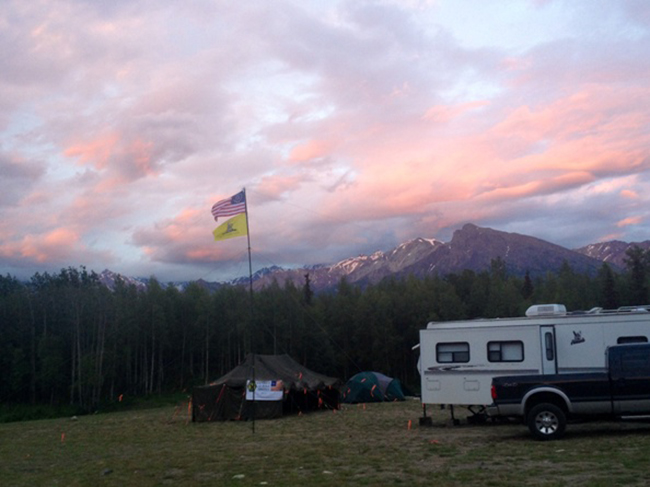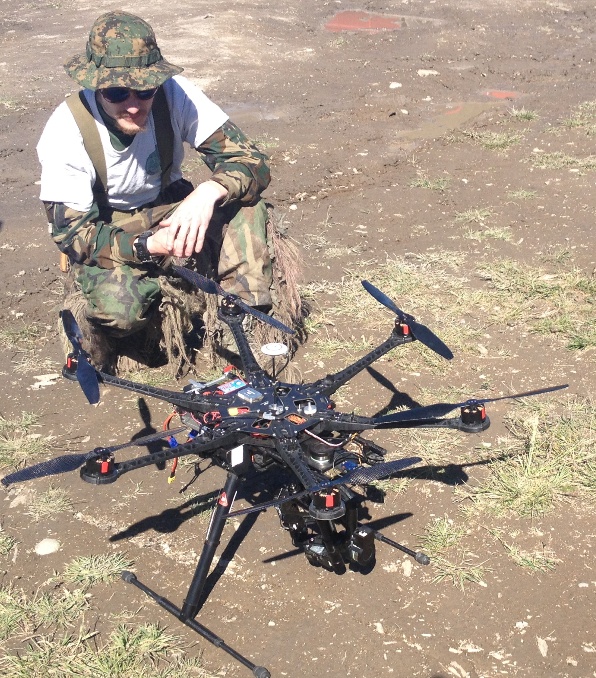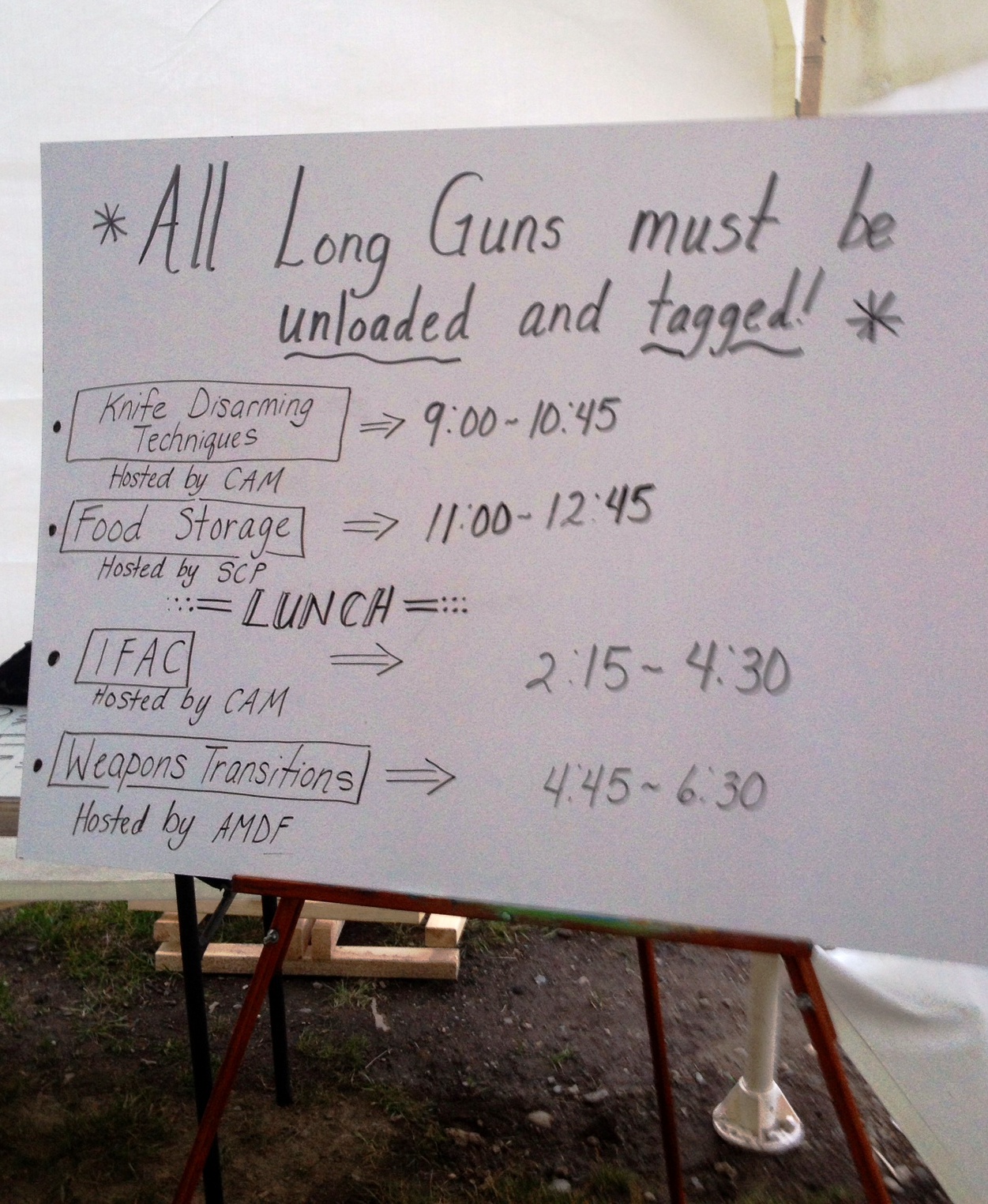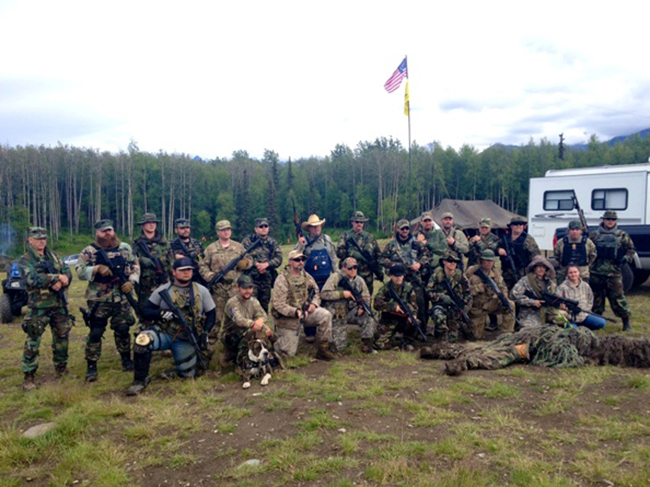
In 2011, members of the Alaska Peacemakers Militia were arrested for conspiracy to commit murder. The trial of their leader, Schaeffer Cox, continually made headlines in the years that followed, most of them bad. Now, other militia groups in the state are trying to show a different side to the movement. I spent three days at a militia gathering in Sutton this summer and brought back this story.
It’s a picture perfect day, and five people in camouflage are marching beneath a crag in the Talkeetna mountains. Rifles are slung across their chests, and an aerial photography drone is hovering over. The man operating the camera is shouting directions.
“We want to get them relaxed – not always ready to rock. Oh, that’s a nice shot of them going away right there ”
The stuff the videographer is getting looks like it’s straight out of an Army recruitment ad. But the people in camo aren’t soldiers. They’re members of the Anchorage Municipality Defense Force, one of the half dozen or so militias operating in Alaska.
Their commander, Mikel Insalaco, came up with the idea of using a drone to film part of the Alaska Prepper, Survivalist, & Militia Rendezvous, an annual training weekend that brings outfits from across the state together.
“We’re supposed to be paranoid about drones but the reality of this is this one has a good purpose,” Insalaco tells me. “We want to be able to get some pretty wicked footage of the event.”

The only thing that Insalaco — or, really, any of the rendezvous attendees — seems paranoid about is seeming paranoid.
The American militia movement isn’t exactly viewed as cuddly. After a series of standoffs with federal agents in the nineties, militias got a lot of attention as a dangerous and fringe anti-government subculture. Locally, the Alaska Peacemakers Militia incident didn’t help that reputation. Cox was sentenced to 25 years in prison for conspiring to kill law enforcement officials and illegally possessing automatic weapons and grenades. Three other members were also incarcerated on similar charges.
Taking in the scene at the militia rendezvous, it’s easy to see how an outsider might be wary. The temporary compound is patrolled by armed men. There are pickup trucks draped in camo netting, and plenty of dudes with beards and tattoos milling around.
David Luntz is one of them.
“Militias get a bad name,” Luntz says during a break from training.
He commands the Central Alaska Militia, which covers a swath of land from Delta Junction to Fairbanks. For all that should make Luntz intimidating, he’s just – well – not. He’s got an easy laugh, and if you talk to him for more than a couple minutes about how he leads the militia, the word “transparency” will inevitably come up.
“We want people to understand what we’re about and support us. These groups that hide and be all secret and they’re not public and open – well, people start fearing them,” says Luntz.
It should go without saying that any motley crew can describe themselves as a militia, and Luntz obviously doesn’t speak for all of them. But the attitude he has is a common one among the groups attending the rendezvous.
“Unfortunately, what happened with [Cox] really hurt the efforts in Alaska, and one of our primary missions in Central Alaska Militia is to change that perception.”
Even though some members of the Alaska militia movement believe Cox was a victim of entrapment, many rendezvous attendees distance themselves from and are even critical of the Peacemakers. They’re eager to show their militias are about more than clashing with government.

For Luntz, the militia’s about a few things. He describes it as a “community defense” group where the people involved learn solid survival skills. Outside of a couple digs at the United Nations, there’s not a lot of talk at the rendezvous about one-world government or taking on the Feds. You’re more likely to hear about preparing for what some call “general infrastructure failure,” and being ready for natural disasters — and maybe alien or zombie attacks. (Driving that home is one attendee’s ammo dog, who wanders the compound in a camo pack that reads “Zombie Response K-9.”) So, in addition to sessions on weapons transitions and close-quarter tactics, there’s also training on food storage and first aid.
“I think that some people are a little apprehensive to come out and run around in BDUs [battle dress uniform],” says Luntz. “The militias and these groups that are formed have a lot more positions that people could partake in that doesn’t involve running around in fatigues and army gear.”
Luntz also gets a sense of camaraderie from his militia. He was in the Army for 20 years, and now he does defense work for – yes – the federal government.
And as a member of the Constitution Party and a strong believer in the Second Amendment, Luntz sees his involvement in the Central Alaska Militia as a basic exercise of his rights. But he doesn’t think of his militia as right-wing or even explicitly political.
“You know, we don’t not accept people because they’re a liberal or they’re whatever. As long as you support the Constitution and our form of government and our Republican setup, then you’re pretty much good,” Luntz says, before laughing. “Just so long as you’re not a felon or a sex offender.”

Yup, the Central Alaska Militia runs background checks on potential members. And at the rendezvous, there are plenty of rules they agree to for safety reasons that would be unacceptable to them if imposed by government. They require attendees to have their pistols holstered and unloaded, and prohibit anyone from handling a gun if they’ve had anything to drink within the past eight hours. The rules are as strict as a shooting range, and much stricter than state law.
And as far as government goes, Luntz says they’ve given the State Troopers their standard operating procedures. They also reach out to the boroughs, the state, the Feds whenever they hold an event on public land.
“You know it’d be kind of easy for somebody to be on the other side of this big compound here and out camping for the weekend, and they see us, and they’re like, ‘Oh my god! They have guns,’ and they call the troopers, ‘There’s a bunch of people with guns!’” says Luntz. “So, we make those public contacts.”
As it turned out, the Troopers did get called to the area … but not because of the rendezvous. In fact, not a single shot was fired the whole weekend by the militia crowd. The Troopers were there because a separate party sprouted up near the compound on the last night. There were drunk people driving four-wheelers, a couple of cases of indecent exposure, and shots being fired well into the morning.
At breakfast the next day, there was some talk about how rowdy the party-goers were and how they were glad the compound had a perimeter set up. At the end of the conversation, one person commented while shaking his head, “And we’re supposed to be the guys people are afraid of.”
